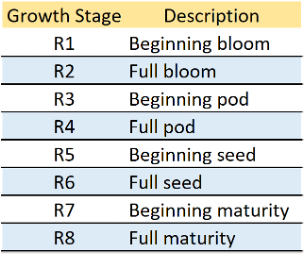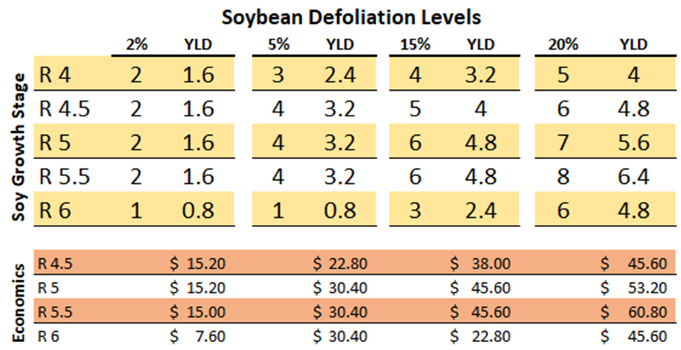The reproductive stages of the soybean plant are focused on producing high pod counts and, more importantly, preserving as many as possible. During this time, a soybean plant is trying to balance its hormones and determine what number of pods and seeds it can successfully feed and finish. Stress (disease, nutritional, insect, water, or heat) during these stages can cause the plant to eliminate pods and seeds.
High-yielding corn growers and agronomists say, “manage to black layer.” This means, don’t give up on a crop until it’s done. I have documented that when a corn plant reaches ¾ milk line there’s roughly 24 percent yield left to be converted from a sugar to starch, which means don’t give up until black layer. This concept is also applicable to soy. Soybeans are strategically managed all season long to offset stress during grain fill.
Strategic Management:
Early Season: Anything associated with improving emergence and early vigor.
- Seed treatments allow for early planting dates, while ensuring adequate stands.
- Starter fertilizers provide plant available nutrients close to the root zone.
- Residual herbicides reduce early season pressures.
Middle Season: Anything associated with reducing developmental stresses.
- Proper variety placement/selection (genetic by environment).
- Weed suppression allows more nutrients, water, and sunlight to be available to soybean plants.
- Fertility is crucial. Feed the crop; don’t just expect it to live and thrive off the leftover nutrients from the previous corn crop.
Late Season: Late season management has been limited to a fungicide and insecticide application at R3-R4 growth stages. These practices can reduce stress during bloom and pod development. Soybean producers understand the importance of keeping the vegetation growth strong and plentiful during mid to late grain fill. In more recent years, seed treatments such as ILeVO and Saltro are an early season management decision, however, they provide value against SDS which impacts late season development.
Once the final plane or ground rig pass is made, one may think that it’s over, remember ¾ milk line corn – there’s still yield to be converted. Soybeans may not be as easy to determine or see late season yield reduction, however soybean yields can still be negatively or positively impacted through R5.5-R6. It comes down to protecting the canopy and keeping photosynthesis going as long as possible.
R4.5 and Beyond: If most final applications are made at R3-R4, is this protection lasting long enough? Stress can still impact yield at growth stage 4.5 and beyond.
The below chart represents the different levels of soybean leaf defoliation. Note: For economic impact, these levels must be observed across all leaves. The insects typically causing this issue can also impact pod quality, seed quality and ultimate pod retention.





 and then
and then